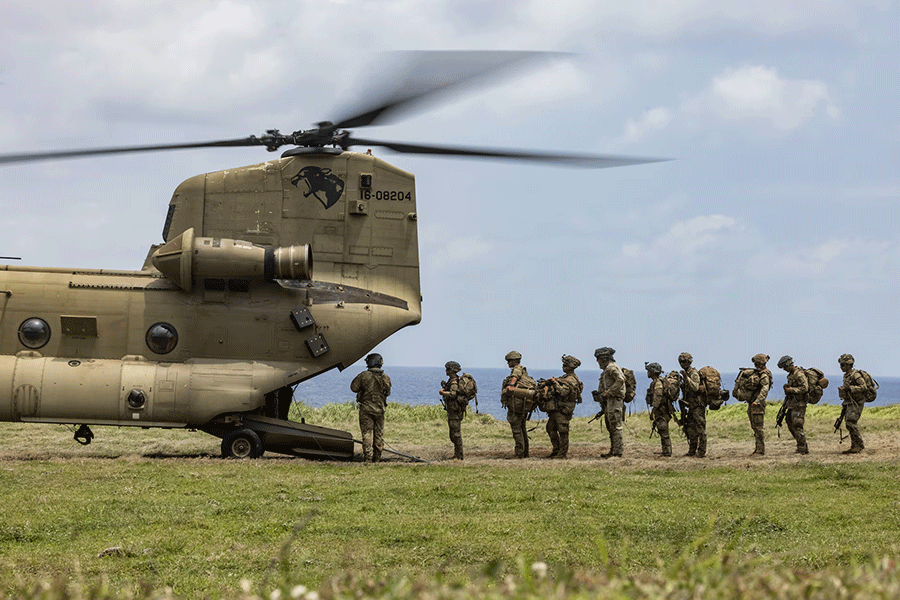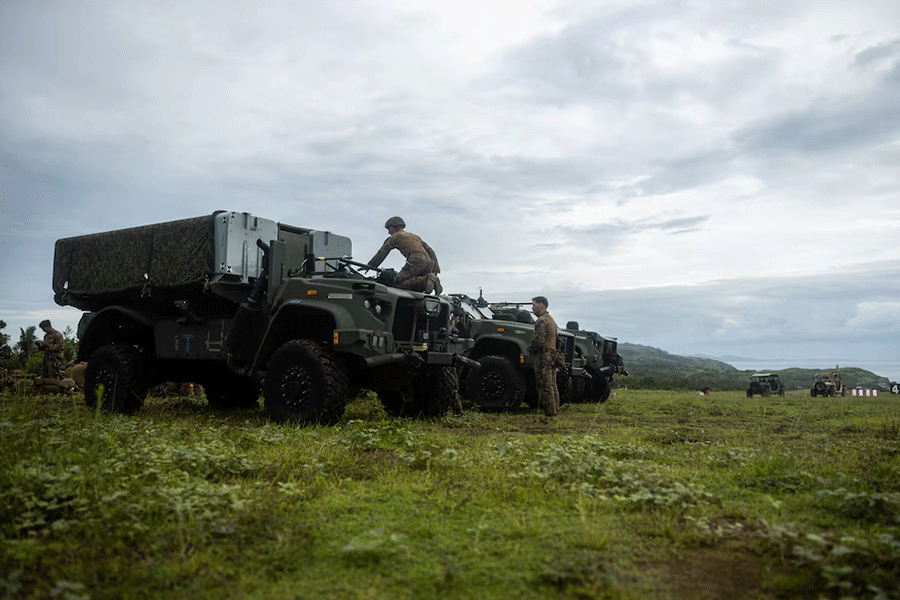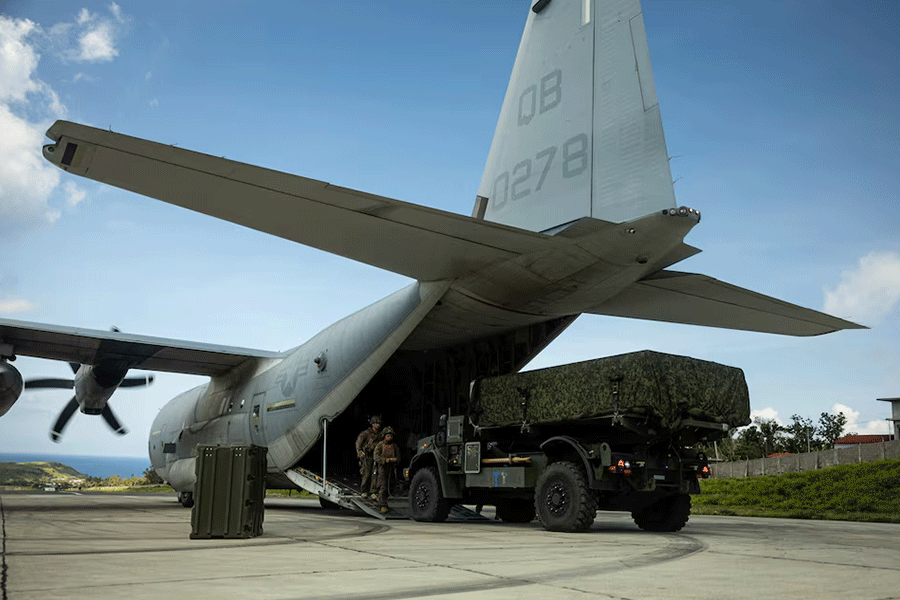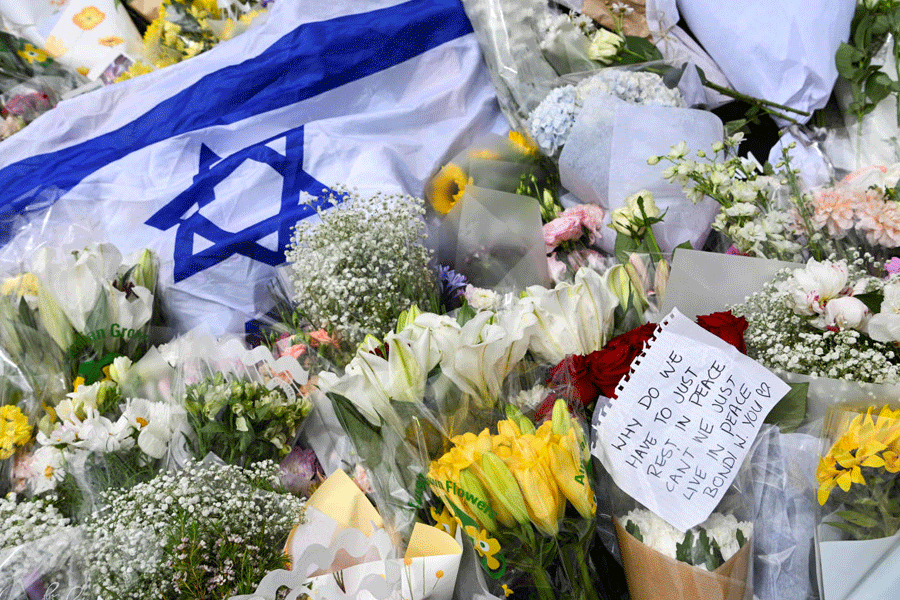 Tuesday, 16 December 2025
Tuesday, 16 December 2025
 Tuesday, 16 December 2025
Tuesday, 16 December 2025
Marilyn Hubalde still remembers the first time she heard the thunderous chop of military helicopters swooping over this northernmost outpost of the Philippines, less than 90 miles from Taiwan. It was April 2023, when Filipino and American troops descended on the cluster of 10 emerald green islands of Batanes province for amphibious warfare drills.
“We were terrified,” the 65-year-old Hubalde recalled. “We thought China might attack when they learned there were military exercises in Batanes.” Hubalde’s helper, who was in the fields when the troops arrived, panicked and hid in the woods until nightfall. “She thought the war had already started,” said Hubalde, who owns a variety store in the provincial capital, Basco.
Since then, Batanes’ 20,000 residents have become accustomed to high-tempo war games in these islands of tightly packed towns and villages wedged between rugged slopes and stony beaches. Among them: a series of joint exercises from April to June this year in which U.S. forces twice airlifted anti-ship missile launchers here.
Until recently, locals say, this smallest and least populous province of the Philippines was a peaceful backwater. But geography dictates that it is now on the frontline of the great power competition between the United States and China for dominance in the Asia-Pacific region. The islands sit on the southern edge of the Bashi Channel, a major shipping lane between the Philippines and Taiwan that connects the South China Sea with the Western Pacific.
This year’s exercises revealed how the U.S. and its Philippine ally intend to use ground-based anti-ship missiles as part of efforts to deny the Chinese navy access to the Western Pacific by making this waterway impassable in a conflict, Reuters reporting shows. These missiles could also be used to attack a Chinese fleet attempting to invade Taiwan or mount a blockade against the democratically governed island.
The ability to conduct operations deep into the Pacific would be vital for the Chinese navy if it wanted to counter U.S. and Japanese attempts to intervene in a Taiwan crisis. Chinese naval and air forces would also need to operate in the Western Pacific to stymie any counter-measures by the U.S. and its allies if Beijing imposed a blockade on Taiwan.
“We should have the ability to deny the Chinese control of the Bashi Channel,” retired Rear Admiral Rommel Ong, a former vice-commander of the Philippine Navy, told Reuters in an interview. “In a conflict scenario, that decisive point will determine who wins or who loses.”
Retired General Emmanuel Bautista, a former chief of staff of the Armed Forces of the Philippines, put it even more plainly: “The invasion of Taiwan is almost impossible if you don’t control the northern Philippines.”
China views Taiwan as its own territory, and President Xi Jinping has said that Beijing refuses to renounce the right to use force to gain control of the island. Taiwan's government rejects China's sovereignty claims, saying only the island's people can decide their future.
“The Taiwan issue is China's internal affair,” the foreign ministry in Beijing said in response to questions. “How to resolve it is solely China's own business and does not warrant interference from others.” The ministry also said it advised the Philippines “against using any pretext to draw in external forces” and not to provoke confrontation and create "tensions in the South China Sea.”
The Pentagon did not respond to questions. Taiwan’s defense ministry declined to comment for this story.
Using the ‘first island chain’
American deployments to Batanes are part of a wider Pentagon strategy to exploit the position of the Philippine archipelago to deter or defeat a Chinese attack on Taiwan or other contested territory in the South China Sea, according to current and former senior U.S. and Philippine defense officials and military officers. The nation of more than 7,600 islands interspersed with key maritime chokepoints is a crucial link in the so-called First Island Chain – the string of territories under the control of America’s regional allies that runs from the Japanese islands in the north and extends through Taiwan, the Philippines and on to Borneo in the south. This chain forms a natural barrier that encloses China’s coastal seas, containing its rapidly expanding navy.

“By divine design, we have been put here, the archipelago has been put here,” said Rear Admiral Roy Trinidad, the Philippine Navy’s spokesperson. “It just so happened that we are the toll gate between the South China Sea and the Pacific Ocean.” Washington appears determined to help Manila keep the toll gate closed if necessary. As Reuters reported in August, some U.S. allies in Asia harbor doubts about President Donald Trump’s commitment to long-standing American security guarantees. Still, Washington is continuing efforts that began under President Joe Biden to bolster defenses along Manila’s stretch of the island chain.
The picture that emerges of current U.S. engagement in the Philippines is dramatic: The joint exercises in Batanes are part of an intensifying series of deployments and rotations of U.S. forces in the Philippines that now amount to a permanent American military presence in the country, Reuters reporting shows. More than three decades after Manila ordered the U.S. to leave its sprawling naval base at Subic Bay in 1992, ending almost a century of American military presence on Philippine soil, U.S. troops are now involved in virtually continuous training and drills at different points in the archipelago.
When the chief of staff of the Philippine Armed Forces, General Romeo Brawner, met the head of the U.S. Indo-Pacific Command, Admiral Samuel Paparo, in Hawaii in August, the two sides agreed to more than 500 joint engagements for 2026, from large-scale exercises to exchanges of experts on smaller topics, according to an official U.S. military statement. U.S. Secretary of Defense Pete Hegseth told a congressional hearing in June that a priority for the Trump administration was modernizing the capabilities needed to “deny Chinese aggression in the First Island chain.” He confirmed that the scale and duration of this joint training were increasing. “In the Philippines, we maintain a robust rotational force presence and we have extended the timelines of exercises with the Philippines,” he said.
For Washington, this cooperation from the administration of President Ferdinand Marcos Jr. is crucial if Chinese forces are to be contained inside the island chain in a conflict. Marcos’ predecessor, the populist firebrand Rodrigo Duterte, was openly hostile to the U.S. and attempted to bring his country closer to China during his six-year term. If China and America go to war over Taiwan, Marcos says his country’s proximity to Taiwan means it would inevitably be drawn into the conflict. “We do not want to go to war,” he said at a press conference in August. “But I think if there is a war over Taiwan, we will be drawn kicking and screaming, we will be drawn and dragged into that mess.”
The Philippine defense ministry said it had “no reason to doubt the commitments made by the highest officials of the Trump administration.”

Recent Chinese maneuvers show how access to the Bashi Channel is critical for Beijing’s plans in the Pacific. In June, a powerful Chinese navy aircraft carrier battle group used this passage to enter the Western Pacific before launching an extended series of exercises south of Japan, according to Japanese military tracking data. The strategic position of the Philippines explains why China has intensified its so-called “gray-zone” warfare aimed at intimidating the Marcos administration and undermining its ties with Washington, according to senior Philippine government officials and former military commanders.
This almost constant harassment of Philippine law enforcement vessels, military patrols and fishing boats falls just short of open conflict. It mostly takes place inside Manila’s Exclusive Economic Zone in the South China Sea. But there are signs that this tactic is now also being employed in the north around Batanes. The Philippine Navy said in a statement that it had detected and challenged “multiple” Chinese naval and coastguard ships in early August making an unauthorized incursion into the Philippines' economic zone near these islands.
Asked about Beijing’s gray-zone tactics, the Philippine defense ministry said, “China’s actions are rooted in its own ambition to change the global rules-based order and position itself as the new global power.” The Philippine military called them “acts of intimidation” that “violate international law.”
China’s foreign ministry didn’t respond to specific questions about gray-zone warfare.
War jitters in Batanes
For those living next to key passages through the archipelago, the preparations for conflict have left communities feeling vulnerable. In Batanes, Hubalde said she rushed out to buy sacks of rice when the 2023 exercises started. Others stocked up on oil, sugar and milk, she said. The islands rely almost entirely on regular shipments of food, fuel, medicine and other supplies from the mainland.

The newly elected provincial governor, Ronald “Jun” Aguto Jr., said the community has become accustomed to the military presence after earlier alarm and panic buying. “So, we had to educate them and tell them that, you know, this is just a military exercise,” he said.
But Aguto is preparing for war. One of his priorities is to update the provincial contingency plan which anticipates a mass influx of overseas Filipino workers, referred to as OFWs, from Taiwan in the event of a conflict. There are about 200,000 Filipinos in Taiwan.
“One scenario in our contingency plan is to use Batanes as a launch pad to bring home OFWs from Taiwan,” he said in an interview at his home in the town of Ivana on the province’s main island of Batan in late June, just before taking office. “But, our islands are designed to support 20,000 people. We have to bring them back to the mainland where their sustainability will be more realistic.”
The military is already working on a rescue plan, Commodore Edward Ike De Sagon, the former Philippine Navy commander for Northern Luzon, told Reuters in an interview ahead of his retirement earlier this month. De Sagon, a native of Batanes, told Reuters that the military was preparing with other government agencies for multiple scenarios, including managing an influx of Filipino workers and “possibly refugees from Taiwan and other nationalities.”
The Philippine military said “due to its geographic location,” Batanes may “serve as a logistical and staging hub” for troops “assisting in evacuation, relief transport, and humanitarian response.”
There is also the danger the islands could be caught up in fighting should Beijing decide to attack Taiwan. Some exercises earlier this year suggest that military planners in Manila and Washington anticipate that China might attempt to attack or seize Batanes if it went to war over Taiwan. Alongside the anti-ship missile drills, American and Philippine troops were landed on the islands to seize and hold important terrain and infrastructure, according to an official U.S. military account of the deployments.
If this scenario plays out, it would not be the first time war comes to Batanes. Hours after Japan’s December 1941 attack on Pearl Harbor, Japanese troops from Taiwan landed on the main island of Batan in the opening phase of a successful battle to drive American forces out of the Philippines. Then, as now, the islands are a strategic prize.
With the tempo of military exercises in the area increasing, one of the province’s most influential residents, retired politician Florencio Abad, has called on authorities in Manila to reassure an anxious local population about plans for handling the impact of a conflict. “I was concerned that history will repeat itself,” said Abad, former budget secretary in the administration of the late President Benigno Aquino and a member of one of Batanes’ most prominent families.
“I’m not even thinking about livelihood,” the 71-year-old said in an interview at his hilltop home, with sweeping views over the Pacific Ocean. “I’m just thinking about surviving a war that is so close to us. Even if we do not get directly involved, we may have to take precautions. What if it is not possible to travel by sea or travel by air? How do we feed ourselves?”
He said the Marcos administration had yet to explain its plans for evacuating Filipino workers from Taiwan or an anticipated influx of Taiwanese refugees fleeing war in ships and boats.
“We are working on comprehensive contingency and repatriation plans," the Philippine defense ministry said, without elaborating.
Missiles ‘designed to close a strait’
While locals worry about conflict, the rehearsals for blocking the Bashi Channel continue. As part of the U.S.-Philippines annual Balikatan, or “shoulder-to-shoulder” drills, the American military in April airlifted in a contingent of U.S. Marines. They brought one of their compact, new NMESIS ground-based anti-ship missile launchers to Batan’s spectacular airport, which slopes uphill towards the foot of a volcano, Mount Iraya. The NMESIS launches the stealthy Naval Strike Missile, which has a range of more than 300 kilometers.
From this position, hostile warships attempting to transit the Bashi Channel or operating in the seas to the east or west of Taiwan would be within range of these missiles. The missiles provided “sea denial capability,” the U.S. military said in a statement. As Philippine Navy spokesperson Trinidad told Reuters, the missile “is designed to close a strait.”
In a further series of drills beginning in late May, the NMESIS system was again airlifted to Batanes and moved into a concealed position as part of simulated strikes against shipping targets, according to an official U.S. military statement on the exercises. U.S. and Philippine marines patrolled through the islands, practising the seizure and defense of key terrain, airports and ports.
Just days after U.S. Marines deployed NMESIS, the Chinese navy aircraft carrier Shandong and its supporting battle group sailed through the Bashi Channel to enter the Western Pacific, according to Japanese military tracking data. The Chinese carrier launched fighter jets and other aircraft in intensive exercises south of Japan before returning late in the month to the South China Sea with its escorting warships via the Bashi Channel, the tracking data showed.
At about the same time, China’s other operational carrier, the Liaoning, entered the Western Pacific through the key Miyako Strait northeast of Taiwan and near Okinawa in Japan to conduct similar exercises with its escorting warships. In a major conflict, Japan’s modern and powerful military would be expected to deny the Chinese navy access to the Miyako Strait and other waterways further north, according to retired Philippine military commanders. That makes the Bashi Channel even more important to Beijing, they say.
“China appears to be seeking to enhance the operational capabilities of its two active aircraft carriers and to improve its ability to conduct operations in distant maritime and air areas,” Japan’s defense ministry said in response to questions.
Asked about the activities of the two aircraft carriers, the Philippine military said they formed part of China’s “continuing illegal, coercive, aggressive, and deceptive (ICAD) activities across the region.”
In a similar threat to Chinese warships, the U.S. Army last year deployed one of its recently introduced ground-based Typhon launchers, armed with two types of potent anti-ship missiles to the major Philippine island of Luzon, just south of Batanes. One of them, the Tomahawk, has a range of at least 1,600 kilometers, which means it could also strike targets deep inside China.
Manila has said it would welcome further deployments of these weapons, despite angry protests from Beijing. China has warned that the deployment was “very dangerous” and demanded the Philippines remove the launchers.
In response to questions, China’s foreign ministry said “regional peace and stability” was being undermined by the “frequent, highly targeted military exercises conducted by the United States and the Philippines in the region, alongside the deployment of strategic offensive weapons such as the Typhon.”
Philippine military chief Brawner said in a local radio interview this month that the anti-ship missile systems weren’t meant specifically for targeting China, but “are here to train us because once we buy these capabilities we should be ready to use them.”
Asked about the Typhon and NMESIS, the Philippine defense ministry said it could “neither confirm nor deny whether these systems remain in the country or where they are currently located. This is a matter of operational security.”
The Philippine military said the presence of such missile systems “in past exercises was temporary.” Their use, it added, was “purely for training and deterrence and not directed at any specific country or intended to close any maritime passage such as the Bashi Channel.”
If China doesn’t like it, ‘we’re doing it right’
Senior current and former Philippine defense officials say China’s anger is evidence that it views these anti-ship missiles as a serious threat. “My personal rule of thumb is that if the Beijing Ministry of Foreign Affairs spokesman talks about it and they don’t like it, that means we’re doing it right,” said Ong, the retired rear admiral.
The Philippine military is also fielding advanced, ground-launched anti-ship missiles. In April last year, Manila took delivery of its first battery of BrahMos supersonic anti-ship cruise missiles, as part of a $375 million order from India. BrahMos missiles carry a 300-kilogram warhead over a range of up to 500 kilometers, according to the Center for Strategic and International Studies. With missiles like these, mobile ground forces dispersed along the island chain could attack Chinese warships and land targets while remaining difficult to detect and counter, former U.S. commanders have explained. This strategy is designed to avoid concentrating forces at established bases in the Asia-Pacific region that would be vulnerable to China’s huge arsenal of ballistic and cruise missiles, they say.
Other joint drills involving forces from the Philippines, the U.S., Japan and Australia suggest similar plans are being rehearsed to block chokepoints further south in the Philippines. Other key passages in the archipelago include the Mindoro Strait, the Balabac Strait and the Sibutu Passage, say senior ex-Philippine military officers. The Marcos administration has also granted the U.S. access to four new military sites, three of them in the north of Luzon, just south of Batanes. As soon as one joint exercise with the Americans concludes, another begins, often involving other close allies. In late August, the Philippine military opened a new forward operating base for navy and marine units on Batan island at the coastal town of Mahatao.
The Trump administration is also rolling out the diplomatic red carpet. Two days after Trump was sworn in, U.S. Secretary of State Marco Rubio on January 22 assured Manila of America’s “ironclad commitments” under its defense treaty in a call with then Philippine Secretary of Foreign Affairs, Enrique Manalo. Rubio also exempted $336 million for modernizing the Philippines' security forces from a freeze on overseas aid implemented by the administration. On July 22, Marcos became the first leader from Southeast Asia to meet Trump in the U.S. president’s second term.
Despite the stepped-up exercises and maneuvers, Batanes Governor Aguto said he is confident China would not attack or land on the islands because it would spark a much wider conflict. Still, he said, for a community that relies on regular shipments of supplies, it made sense to prepare for the worst.
That’s how Basco store owner Marilyn Hubalde is thinking, too. She has turned her mind to survival if war interrupts Batanes’ regular shipments of supplies. Locals will need to go back to growing their own food on the islands’ rich volcanic soil, she suggests. “We really need to start planting,” she said.







